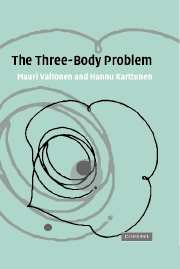
- Publisher:
- Cambridge University Press
- Online publication date:
- December 2009
- Print publication year:
- 2006
- Online ISBN:
- 9780511616006
- Subjects:
- Physics and Astronomy, Astrophysics

How do three celestial bodies move under their mutual gravitational attraction? This problem has been studied by Isaac Newton and leading mathematicians over the last two centuries. Poincaré's conclusion, that the problem represents an example of chaos in nature, opens the new possibility of using a statistical approach. For the first time this book presents these methods in a systematic way, surveying statistical as well as more traditional methods. The book begins by providing an introduction to celestial mechanics, including Lagrangian and Hamiltonian methods, and both the two and restricted three body problems. It then surveys statistical and perturbation methods for the solution of the general three body problem, providing solutions based on combining orbit calculations with semi-analytic methods for the first time. This book should be essential reading for students in this rapidly expanding field and is suitable for students of celestial mechanics at advanced undergraduate and graduate level.
'… covers a wide range of both theory and applications of an issue central to basic physics. … In the first five chapters, the authors provide a classical mechanics course that goes well beyond the ordinary graduate textbooks. … The authors' main achievement is their coverage in the last five chapters of the many different applications in astrophysics in which one of the three bodies is much lighter than the other two. … In The Three-Body Problem, readers will find the necessary theoretical ingredients and will also enjoy the great variety of technical explanations for phenomena in the solar system and beyond. The book would be useful for a graduate course in modern astrophysics and makes interesting reading for an amateur who has some background in classical mechanics.'
Source: Physics Today
' … a well-judged and fundamental book [on a] subject of permanent value.'
Source: Celestial Mech. Dyn. Astr.
 Loading metrics...
Loading metrics...
* Views captured on Cambridge Core between September 2016 - 13th April 2025. This data will be updated every 24 hours.
Usage data cannot currently be displayed.